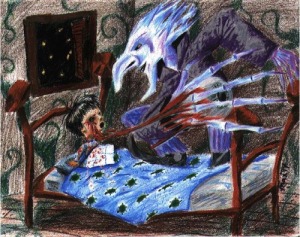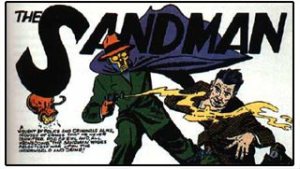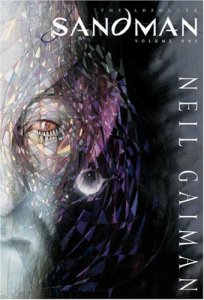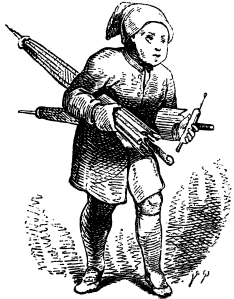First time I lost a tooth, I ran to the top of the steps and yelled, “My tooth came out!” I couldn’t see my mother in our laundry room, but she performed a reasonably convincing shout of excitement, ending with: “Looks like someone’s getting a visit from the tooth fairy tonight!”
My five-year-old body went rigid. Blood drained from my face. Tooth fairy? Who the hell was the tooth fairy?
I must have a gothic disposition, because I assumed this creature would be coming for the rest of my still-attached teeth. One of Poe’s narrators does that, plucks out his beloved’s beautiful incisors and bicuspids with a pair of pliers. But Germany’s E. T. A. Hoffman is the better source for inverted fairies. A student in my English Capstone assigned the 1816 “Der Sandmann” to our class earlier this semester. Hoffman takes the harmless Sandman, bringer of sleep to dozy children, and twists him into “a wicked man” who “throws handfuls of sand into their eyes, so that they jump out of their heads all bloody; and he puts them into a bag and takes them to the half-moon as food for his little ones.”
That’s the guy Metallica is singing about. Although the Hans Anderson version isn’t all goodnight kisses either. Ole-Luk-Oie, the Dream-God, may be very “fond of children,” but if you’ve been naughty, he holds a black umbrella over you all night so come morning you’ve dreamt nothing at all. His sibling is named Ole-Luk-Oie too, except “he never visits anyone but once, and when he does come, he takes him away on his horse, and tells him stories as they ride along. He knows only two. One of these is so wonderfully beautiful, that no one in the world can imagine anything like it; but the other is just as ugly and frightful, so that it would be impossible to describe it.” The other Sandman isn’t a Dream-God. He’s Death.
I prefer Hoffman’s eye-plucking fairy. He reveals “the path of the wonderful and adventurous” as the child-narrator tries to unmask him. That’s right, “the terrible Sand-man” is a dual-identity supervillain. The kid recognizes his father’s business partner, a literally Satanic lawyer who practices alchemy by night. If the Faust allusions aren’t clear, then note his “sepulchral voice” and the laboratory explosion that kills the hapless dad. Hoffman even quotes Goethe after strumming the ubermench theme song: “Father treated him as if he were a being from a higher race.”
Enter Golden Age comic writer Gardner Fox. He must have spent a lot of time under Ole-Luk-Oie’s other umbrella, the one with the pictures twirling on the inside. He dreamt up the Flash, Hawkman, Dr. Fate and the Justice Society of America. Bill Finger usually gets credit as Batman’s original writer, but Fox wrote six of the first eight episodes, each almost twice as long as Finger’s introductory 6-pagers. Instead of apprehending jewel thieves and serial killers, Fox’s phantasmagoric Dark Knight faces down a werewolf-vampire and some guy who steals faces and puts them on talking flowers.
When Finger returned Batman to the grit of crime alley in 1940, Fox dreamt up the Sandman, your standard fedora-wearing Mystery Man, except in a World War I gas mask. He stole his knock-out pellets from Batman’s utility belt (a Fox invention), though they’d already been field-tested by Johnston McCulley’s Bat and WXYZ’s Green Hornet. When Jack Kirby and Joe Simon got tired of spinning Timely’s umbrella of characters, they traded in the Sandman’s business suit for a red and yellow leotard and a sidekick named Sandy. They kept the color scheme when they revised him again in 1974, this time as the Sandman of Hans Anderson lore, a protector of children’s dreams. That’s the dopey series Neil Gaiman reawakened in 1988.
I was too busy mourning the collapse of Alan Moore’s short-lived Mad Love company to take adequate notice at the time. Gaiman stripped off the leotard, but I still considered his white-skinned Morpheus just another superhero reboot. I thought the future of comics was Moore and Bill Sienkiewicz’s Big Numbers and Dave McKean’s Cages. I was wrong. McKean’s publisher Tundra died almost as fast as Mad Love. I’m sure he made better money painting Sandman covers anyway.
Sandman is easily the best-selling and best-regarded comic of the 90s. When I attended a comics forum last month, it was the only work to receive its own three-scholar panel. Unfortunately the forum was in Michigan after a bout of “snow thunder” had reduced the state to a lake of frozen slush, and none of the three panelists showed up. Maybe the empty podium was their way of evoking a night spent under the Sandman’s black umbrella.
I prefer Gaiman’s non-graphic novels anyway. Stardust was one of the last books I read aloud to my kids, my wife regularly teaches American Gods, and Coraline once shattered an MFA-induced writing block of mine, not just its twirling dreamscape, but the deceptively Stein-esque simplicity of its sentences. This also lea\d to a parenting low point when my wife and I refused to leave a matinee of the film adaptation even though our son was trying to claw over the back of his seat to escape. And yet the emotional scars did not prevent him from later writing a book report on Neverwhere. He likes Good Omens too.
Like Hans Anderson, DC spun-off the Sandman’s sibling Death, but when Gaiman killed Sandman, his contract stipulated that it would stay dead. Because, as Ole-Luk-Oie warns his listeners, “You may have too much of a good thing.” I was paying enough attention to buy that 75th and final issue, a riff on Shakespeare’s Tempest. It turns out the bard is a bit of a Faust himself. The talentless hack accepts a contract as the Sandman’s front man, inundating the world with dream stuff for centuries to come. “There is nobody in the world,” wrote Hans, “who knows so many stories as Ole-Luk-Oie, or who can relate them so nicely.”




So the Sandman was an insidious friend-of-the-family in Hoffman’s version? Interesting. I believe Hoffman also wrote The Nutcracker, where Drosselmeier plays a similar, if more ambiguous role. Drosselmeier in his youth is arguably the hero in ‘The Hard Nut’ story within the story, and he is the only one who takes Clara’s fever-dreams seriously, knowing what they actually are.
I loathed Neverwhere.
So…I did a hail mary and tagged Neil Gaiman, who retweeted it.
He says he forgot he’d looked at the Andersen. Good call, Chris.
I think Stardust is better than Neverwhere, for sure.
I’ve been bing watching HBO’s True Blood, with gratuitous fairy/vampire/werewolf/shapeshifter sex worked into every plotline, so I’m finding the comparison of typical urban fantasy sex with Neverwhere interesting.
I did always sort of get the feel from Gaiman’s Sandman and Neverwhere and other urban fantasyish stuff that it has the feel of a book by a lonely dude in his 20s moping about being single. In fact he was married in 1985 and had a child, according to Wikipedia, but his books never felt like they were written by a married dude who is a parent.
There’s a fair amount of sex in American Gods, though.
“Sandman is easily the best-selling and best-regarded comic of the 90s.”
Did you mean the best-selling comic which is also well regarded? Cause I’m pretty sure Todd McFarlane beat Gaiman regularly with his Spidey sales. And let’s not forget the X titles which I’m almost certain trounced Sandman. Jimmy Corrigan (and others?) are better regarded even among literary types I think. And From Hell? Sandman/Gaiman is loved by way way more people than Jimmy Corrigan/From Hell of course.
So a comic which achieved very good sales over time (though not during initial publication) and above average regard for its early issues? I remember the criticism being not entirely favorable towards its close. The 90s were a pretty bad period for comics it has to be said.
Thanks, Noah. I teach so many dead authors, I forget that the live ones can actually express opinions.
And smart correction, Ng. I was being too flip about sales. Sandman was big but not the biggest, though it may be, as you say, the highest selling of the “best-regarded.”
And though the 90s were indeed bleak, you do have Kingdom Come in 1996, and of course Maus in 1991, so not a completely lost decade, right?
The 90s were willfully made bleak by a bunch of desperate fanboys wanting to make a lot of money and come-off as “grown-up”. What ruined the 1990s were the Marvel workhorse artists deciding they could write (they couldn’t) and forcing the “edgy” trend from the irritating to the utterly ridiculous, and whoever it is who found their copy ofg Action #1 and sold it for a million bucks which got a bunch of simpleminded fanboys thinking they were going to retire on Death of Superman.
I honestly enjoyed quite some comics that came out in the 1990s, even some cape — the first 50 issues of Marvel’s New Warriors (though the art in the end was some dreadful guest penciller) and DC’s Young Justice were quite good, and Peter David’s X-factor/X-force stuff was decent in spite in of the lousy art. The Busiek/Perez Avengers happened then, a great releif after the excruciating Heroes Reborn; Marvels and Kingdom Come were both great, though Ross’s work can be stiff at points. Though there are points in which Sandman is quite weak, I overall like -it- a lot. Plus the aforementioned series that aren’t lumped in with “90s comics” — Jimmy, Love and Rockets, the 1990s Usagi Yojimbo comics were particularly good, Sakai having found his footing after the first few adventures. I also am partial to Dylan Horrocks’ 1998 Hicksville, which satirized the very toxic culture and industry that pervaded the 90s scene until around Marvel’s bankruptcy. (And, actually, every part of the big-time comics scene — the antagonist is basically an ugly Stan Lee/Julie Schwartz/Bob Kane/Etc. pastiche dropped in the 1980s/90s scene)
I think the “ugh, 90s comics” thing is a sort of reaction that happens mostly because in addition to creating uniformly bad comics (as opposed to bad comics that were UNIQUELY bad, what with every Image offering was virtually indistinct, and 90% of DC and Marvel were indistinct from Image except for them not being the rip-offs), it managed to financially destroy and alter the comics culture and industry in a way no time period before had or has since (with the exception of maybe 1954 with Wertham, but comics couldn’t help that, and fanboy culture wasn’t so much a thing). Everyone I know sighs about “90s comics” (Liefeld!!), but everyone also has comics done in the period that they really did love and were actually pretty good. It’s just the face that the decade took on, because being a sort of very transitory time (manga and anime started to get bigger here with Akira’s debut, the Web was being explored as a venue for fandom and webcomics at the end, the CCA was gradually losing ground starting around 1990) that took seriously wrong turns, those turns colored it and sort of overwrote the people who were making good comics.
Also, I had no idea Gaiman had a child in the 1990s. His stuff doesn’t read like it at all.
Let’s not forget that Gaiman wrote some for Spawn!
Anyway, I have never been able to finish any of Gaiman’s non-comic work, except for Coraline, which is quite good and I taught in a Children’s Lit class. Admittedly I have only tried American Gods and Neverwhere, but could not get past the second chapter in each – it has been a while, so I don’t exactly recall what turned me off,except a general aversion to his prose without pictures and a general feeling of boredom.
I have not read Sandman since the late 90s – but one of these days I plan to check in and see if I still love it as much as I once did. I know visually it was astounding.
‘The Graveyard Book’ is an exceptionally good Gaiman novel; his best.
Suat already said it, but this — “Sandman is easily the best-selling and best-regarded comic of the 90s” — is flat out false. On the other hand, this pairing — “Kingdom Come in 1996, and of course Maus in 1991, so not a completely lost decade” — did make me laugh.
Anyway, Hoffman is genius. There’s a good claymation quasi-adaptation here: https://www.youtube.com/watch?v=UjgHbRrnjhU
I really dislike Maus, but even I have to admit it’s substantially better than Kingdom Come (or of the bits of Kingdom Come I’ve managed to get myself to read.)
I think describing Sandman as the most critically acclaimed blockbuster of the 90s is accurate. Yes, there were stronger sellers and more critically well regarded comics, but none that combined prestige and sales to that extent. Focusing on the initial sales of the periodicals and not the success of the collected editions, and their groundbreaking outreach to female readers and the fantasy market, seems quite arbitrary to me.
As for the quality of 90s comics, any decade that saw some of the best work of the alternative comics movement (Clowes, the Hernandez brothers, Bagge, Woodring, Brown, Burns) has to be considered strong. The worst excesses of mainstream comics during that decade just reversed the gains of the best mainstream comics of the 80s, whether with the drooling incoherence of the Image style or the reactionary conservatism of your Kingdom Come, Marvels et al. So it’s a story of the deterioration of the mainstream while alternative genres and audiences were opened up, and Sandman, admittedly a lightweight, younger readers comic, played a role in that.
Lots of good English-language comics in the ’90s:
PULP/ADVENTURE
–Jeff Smith, Bone
–Mark Schultz, Xenozoic Tales
–Mike Baron & Steve Rude, Nexus
–Neil Gaiman with Mark Buckingham and others, Sandman and Miracleman.
–Jamie Delano and collaborators, Hellblazer.
–Garth Ennis with Steve Dillon and others, Hellblazer and Preacher.
–Kurt Busiek with Alex Ross and Brent Anderson, Marvels and Astro City
–Matt Wagner, solo and with collaborators, Batman/Grendel and Sandman Mystery Theatre
–Mike Mignola, Hellboy
–Warren Ellis & Darick Robertson, Transmetropolitan
–Alan Moore & various, the America’s Best titles
ALT/LITERARY
–Alan Moore with Eddie Campbell and Bill Sienkiewicz, From Hell and Big Numbers
–Eddie Campbell, Graffiti Kitchen and How to Be an Artist
–Dave McKean, Cages
–Peter Bagge, Hate
–Daniel Clowes, Ghost World, Like a Velvet Glove Cast in Iron, “Caricature”
–Chester Brown, I Never Liked You
–Jim Woodring, the Frank stories.
–Dave Sim, Jaka’s Story and Melmoth
–Dylan Horrocks, Hicksville
–Gilbert Hernandez, Poison River and Love and Rockets X.
–Jaime Hernandez, “Flies on the Ceiling,” “Spring 1982,” and “Tear It Up, Terry Downe.” I don’t think much of Wigwam Bam, but several prominent people rate it very highly.
I’m probably forgetting a few, too.
Also, it’s not unreasonable to consider Jimmy Corrigan a 2000s comic, not a ’90s one. It was serialized in the ’90s, but most of its readership knows it from the collection, which came out in 2000.
If one goes by completion/collection dates, Maus is a ’90s comic.
After Maus, I think it’s fair to consider to Sandman the most prominent comic of the 90s. It had a lot of buzz around it even outside comics circles, it sold well, and it’s probably had more staying power than anything else from the decade.
Stardust, btw, was originally serialized by DC with illustrations by Charles Vess…so maybe it falls into the comics category. Also Sandman is back these days with a Gaiman-penned prequel. So, it wasn’t dead after all…just sleeping.
Maus may have been finished in the 90s, but to me, it’s so ingrained as one leg in the “comics aren’t just for kids anymore” tripod of 1986, that I think of it an an 80s comic.
RS Martin’s list is a good one, to the Pulp/Adventure list I’d add Morrison’s Doom Patrol and Campbell’s Bacchus.
I’m fond of Moore’s Supreme from the 90s, and although some folks here hate it I’d think Understanding Comics is a canonical 90s comic.
Yes, great list, Robert. Thanks for informing my birthday and Chritmas lists for some time to come.
Thank you, Shelton. I’m in the process of incorporating this post into a larger chapter, so your compliment is perfectly timed!
I hate to say it, Chris, but I think that was spam. But it’s still a good post!